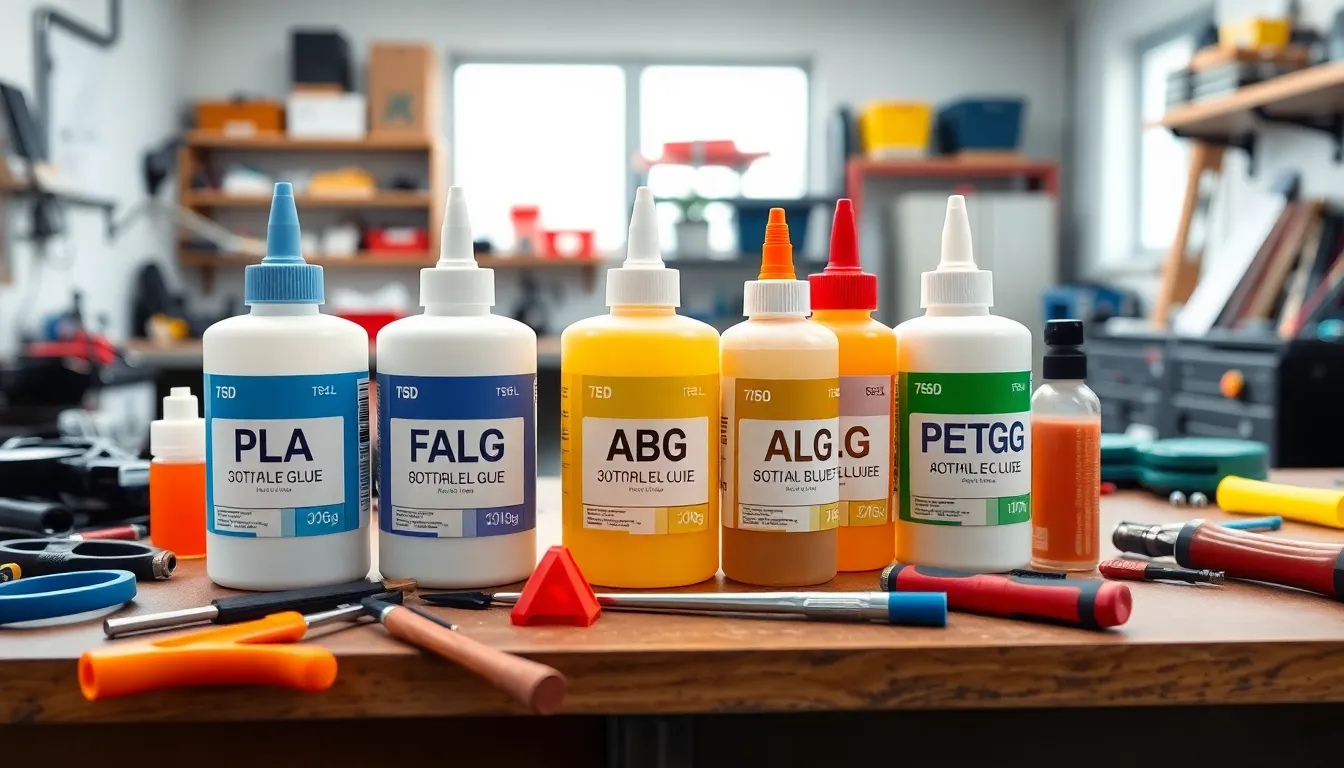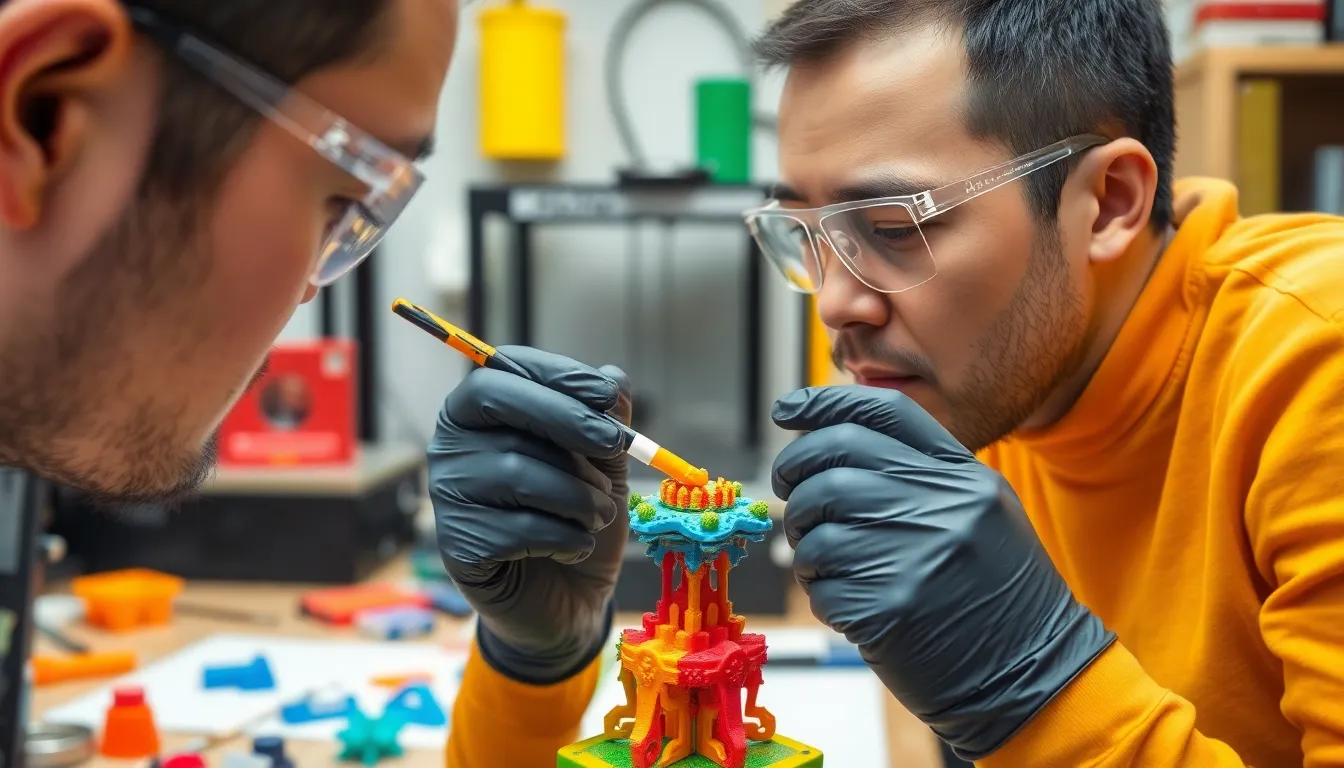In the world of 3D printing, where creativity meets technology, a little adhesive magic can go a long way. Enter 3D printing glue—the unsung hero of the maker movement. It’s not just any glue; it’s the secret sauce that holds your masterpieces together, making sure that your intricate designs don’t end up as a pile of plastic spaghetti.
Table of Contents
ToggleOverview Of 3D Printing Glue
3D printing glue serves a vital function in the creation and assembly of 3D printed objects. This specialized adhesive enhances the strength and durability of models, ensuring stability throughout their lifecycle. Many makers rely on these glues for their ability to bond various filament materials, such as PLA, ABS, and PETG.
Products designed specifically for 3D printing typically feature properties that allow for quick setting and strong adhesion. Certain formulations even include additives to prevent warping and improve flexibility. Adhesives can also cater to specific applications, providing tailored solutions for intricate designs or larger structures.
Types of 3D printing glue vary to meet distinct user needs. For instance, cyanoacrylate (super glue) is renowned for its fast curing time and strong bond, making it ideal for quick fixes. In contrast, PVA glue offers ease of use and is non-toxic, appealing to users seeking a safer option for delicate projects.
Careful application techniques enhance the effectiveness of 3D printing glue. Users should clean surfaces before application to maximize adhesion. Moreover, applying an even, thin layer of glue typically yields the best results.
Understanding the properties of different glues aids in selecting the right adhesive for specific projects. These choices directly influence the final appearance and structural integrity of the print. Overall, 3D printing glue plays an essential role in the maker movement, impacting both aesthetics and functionality in various applications.
Types Of 3D Printing Glue

Different types of 3D printing glue cater to various materials and user preferences. Selecting the right glue impacts the quality and durability of the printed object.
PLA Glue
PLA glue, often PVA-based, offers a safe and non-toxic option for bonding PLA filaments. This glue provides excellent adhesion while being easy to handle. Users appreciate its ability to create strong bonds without the harsh fumes associated with other adhesives. Applying PLA glue involves a simple process of cleaning surfaces and spreading a thin layer for optimal results. Many makers favor this glue for its versatility, particularly in creating intricate models and prototypes.
ABS Glue
ABS glue typically consists of a solvent that melts the surface of ABS filament, creating a strong bond. This adhesive is ideal for repairing and joining ABS parts, ensuring structural integrity. Users often find that it provides excellent flexibility, making it suitable for functional prototypes. To achieve the best results, applying a generous amount while ensuring even coverage is crucial. This method ensures that the bond remains robust and durable under stress or strain.
PETG Glue
PETG glue is designed specifically for PETG filament, enhancing adhesion and durability. This adhesive often utilizes cyanoacrylate or specific formulations for optimal bonding results. It’s known for quick curing times and strong bonds that withstand various conditions. Users should clean the surface thoroughly, and apply a thin, even layer for best performance. This glue’s resistance to moisture makes it an excellent choice for outdoor applications and long-lasting prints.
Applications Of 3D Printing Glue
3D printing glue serves various practical purposes in the realm of additive manufacturing. Applications range from model assembly to surface finishing and repairing prints.
Model Assembly
Model assembly benefits significantly from 3D printing glue. This adhesive facilitates the joining of multiple parts, ensuring a strong and detailed final product. Different glues cater to specific materials, allowing users to select the ideal adhesive for their project. For instance, PVA glue works well with PLA parts, offering a robust bond with low toxicity. Applying glue to clean surfaces increases adhesion, resulting in a better overall finish.
Surface Finishing
Surface finishing achieves remarkable enhancements through the use of 3D printing glue. This adhesive not only bonds materials but also smooths out imperfections between layers. Users often utilize cyanoacrylate for its fast-drying properties during finishing touches. Applying glue creates a seamless appearance, hiding the lines from printing. Sanding the glued areas after application allows for an even smoother surface, making the model more visually appealing.
Repairing Prints
Repairing prints relies heavily on the properties of 3D printing glue. Faulty or broken prints benefit from immediate attention using suitable adhesives. Cyanoacrylate glue quickly fixes minor damages, restoring the integrity of the model. For larger repairs, using ABS glue melts the damaged section, providing a solid reattachment. Effectively filling gaps or cracks leads to a durable end product. Overall, choosing the right adhesive ensures successful repairs, maintaining the quality of 3D printed items.
Choosing The Right 3D Printing Glue
Selecting the right 3D printing glue is essential for ensuring optimal performance and durability in projects. Consider multiple factors, including material compatibility and print properties, when making a decision.
Material Compatibility
Material compatibility directly affects adhesion quality. PLA glue often works best with PLA filaments, as it provides strong bonding without harsh fumes. ABS glue, on the other hand, melts the surface of ABS filaments, creating a robust bond ideal for repairs. When working with PETG, specific PETG glue offers quick curing and moisture resistance. Knowing the materials used in a project facilitates choosing the correct adhesive. Always check manufacturer recommendations for the best results.
Print Properties
Print properties significantly impact how 3D printing glue performs. Some glues feature quick-setting capabilities, enabling rapid assembly of prints. Flexibility and strength characteristics also vary among different adhesive types. For instance, PVA glue is a popular choice for non-toxic projects, while cyanoacrylate provides fast fixes for urgent needs. Each glue’s properties influence its effectiveness and the final look of the printed item. Choosing glue that aligns with the desired print characteristics enhances both functionality and aesthetics.
3D printing glue is an indispensable tool for anyone involved in the maker movement. Its ability to bond various filament materials ensures that creations remain stable and visually appealing. By understanding the unique properties of different adhesives, users can select the right glue for their specific projects, enhancing both durability and aesthetics.
With options ranging from cyanoacrylate for quick fixes to PVA for safer applications, makers can achieve optimal results. Proper application techniques further maximize the effectiveness of these adhesives. Ultimately, the right choice of 3D printing glue not only strengthens models but also elevates the overall quality of 3D printed items, making it a vital component in the world of additive manufacturing.




